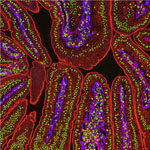
Gail Besner of Nationwide Children’s Hospital and her research team recently found out how the HB-EGF growth factor protein could potentially aid the development of treatments for a number of conditions. Using model systems in two separate studies, the scientists discovered that HB-EGF could protect the intestines from injury by stimulating cell growth and movement and by decreasing substances formed upon intestinal injury that worsen the damage. They also showed that administration of mesenchymal stem cells could further shield the intestines from injury. Future treatments involving a combination of HB-EGF and stem cells could, for example, help cancer patients sustain fewer intestinal injuries resulting from radiation therapy.
This work also was funded by NIH’s National Institute of Diabetes and Digestive and Kidney Diseases.
Learn more:
Nationwide Children’s Hospital News Release


I’m expecting it too soon to be realized that the appendix works as a safe harbor for biota that perform multiple duties in the gut. These would include digestion and protection from invasive bacteria.
Study of biota in children from 1st stool to 7 years or more may show the change in gut biota through ingestion as children age and are exposed to different foods. I know my daughters early stools had a distinct greenish hue to them, which I never expected to see.
Great pictures.
Hi Madam Jilliene Drayton
Is this protein may help intestinal inflammation caused by parasites or fungus?
Thank you
Dr. Besner answered: Intestinal parasites or fungus would need to be treated with antiparasitic or antifungal medications. I don’t think any growth factor is likely to treat those diseases.
Do you think that this could be a potential treatment for the bladder damage in intersticial cistitis?